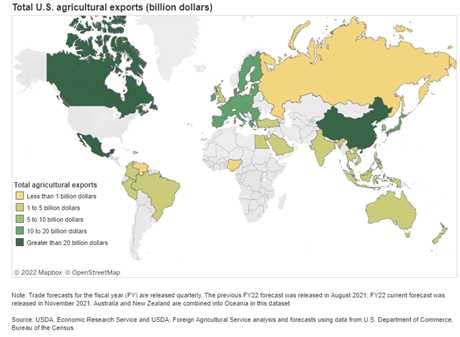You may have heard that Florida’s citrus growers – a dwindling group already – are preparing for yet another challenging year. Citrus greening, fruit drop and weather challenges are the culprit. According to the Florida Department of Citrus, Florida is projected to produce 56 million boxes of oranges this season, which would be the state’s second smallest citrus output in the last 20 years. For those of us who live outside the citrus belt, these impacts may be less obvious – until we buy orange juice and other citrus products. We pay attention when there are food and toilet paper shortages in the store. When those things are gone, everything else pales in comparison.
But farming of all types, not just citrus, affects our economy more than we may realize. Consider the following:
- There were 2.02 million U.S. farms in 2020, comprised of 897 million acres of land, with an average size of 444 acres.
- Gross Cash Farm Income (GCFI) is the total of cash receipts, farm-related cash income, and government- direct farm program payments. GCFI is forecast to be $512 billion in 2022. Farm expenses are projected to increase 6.5% from 2020.
- Small family farms (less than $350,000 in GCFI) accounted for 89% of all U.S. farms. Large-scale family farms ($1 million or more in GCFI) at 3% of farms, accounted for 46% of production in 2020. The United States Department of Agriculture (USDA) reports 97% of small farms are family-owned, though the statistics are confusing at times.
- Median total household income among all farm households was $80,060 in 2020 and exceeded the median total household income for all U.S. households at $67,521. Most farmers earn some off-farm income.
- Cash receipts for crops totaled $198.8 billion in 2020. Corn and soybeans were 40% of the total. The U.S. is the world’s largest corn producer.
- Cash receipts for animals and animal products totaled $165.0 billion in 2020.
- Cattle/calf receipts totaled $63.1 billion at 38.2%
- Dairy receipts totaled $40.5 billion at 24.6%
- Poultry and eggs receipts totaled $35.5 billion at 21.5%
Almost half of agriculture revenue is from meat production. The U.S. is the world’s largest beef and poultry producer. Livestock, poultry, and dairy exports are forecast to increase by $1.9 billion to $38.7 billion.

There have been many factors affecting farming over the decades including:
- Industrial farming - where large farms produce only one big crop
- Mass production
- Technology
- Government subsidies
- Commodity auction prices fluctuating
- Use of chemicals, pesticides and antibiotics
- Resurgence in organic farming
- Weather cycles
But there are some other interesting factors that have affected and will affect farming and we should be concerned about them.
- Groups comprised of activists and politicians have been demanding the U.S. eliminate much of the cattle ranching in the U.S. in order to help reduce carbon emissions. This would have a devastating impact on those jobs, rural communities, our food supply and our exports.
CNBC reports by 2020, Bill Gates had become the largest private farmland owner in the U.S. He has accumulated more than 269,000 acres of farmland across 18 states in less than 10 years.
The CNBC article quotes American Farmland Trust CEO John Piotti:
“It’s an asset with increasing value,” Piotti said. “It has great intrinsic value and beyond that, it is a limited resource.”
According to an interview by MIT Technology Review, Bill Gates thinks “all rich countries should move to 100% synthetic beef.” He is concerned about cow emissions. We might be concerned with the devastation to the agricultural economy and our agricultural export revenue. Gates is a large investor in several synthetic meat companies.
- China is buying farmland in many countries including the U.S. In fact, in 2018 the USDA reported China had increased its farm land holdings in other countries by a factor of ten. This is called a trend.
In the beginning of 2020, Chinese investors owned approximately 192,000 acres of U.S. agricultural land valued at $1.9 billion. Lawmakers from both parties are trying to pass laws prohibiting foreign nationals from owning farm land. Iowa and Minnesota have already passed state laws, imposing restrictions on foreign ownership of farmland. In a past blog I mentioned we were dependent on China for many of our medicines. We don’t want to encourage another kind of dependency.
- The opioid crisis is hitting rural America including famers.
A 2019 printing from the Drake Journal of Agricultural Law states:
“A recent survey by the American Farm Bureau Federation and National Farmers Union, two leading farm organizations, found that nearly 50% of rural adults and 74% of farmers have been directly affected by opioid abuse. This means the individual knows someone that is addicted, has a family member that is addicted, has taken an illegal opioid, or is dealing with addiction themselves.”
These are just a few factors to illustrate how surprisingly connected everything can be. We need to pay more attention because it not only affects our physical lives but also our economy - which again affects our lives.